June 24, 2018
Namibia Part Two
Second of two posts that look at photographing in Namibia. Part 2 – photography tour
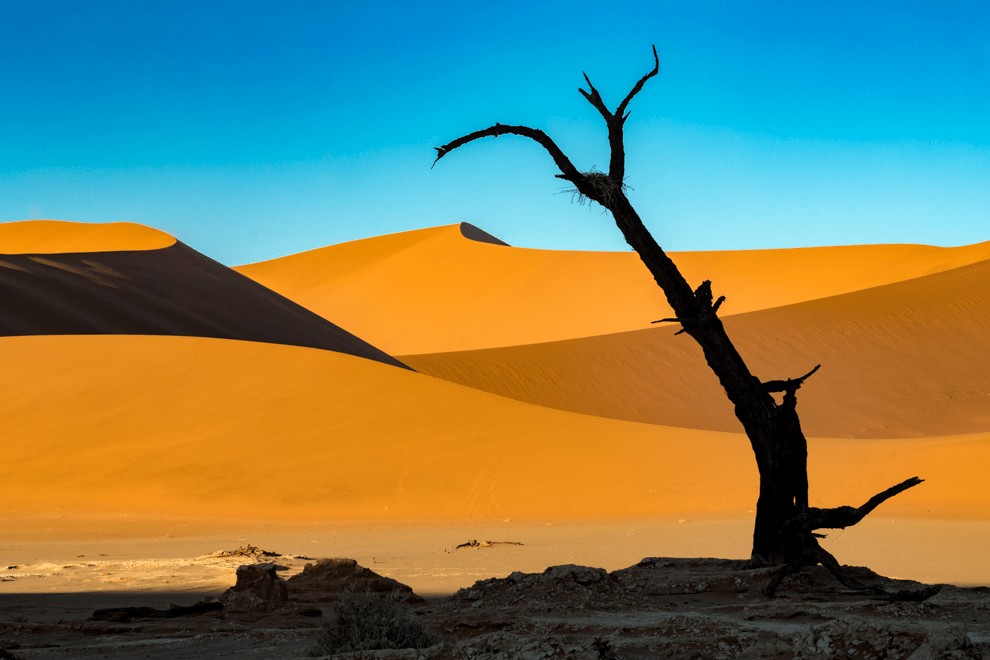
Keetmanshoop
A couple of weeks ago I shared images of a personal trip around the southern African country of Namibia. After a few days in South Africa, I returned to Windhoek. This time I was co-hosting a photography workshop with the Tokyo-based photographer Martin Bailey. Martin’s Complete Namibia tour covers all aspects of the country, taking in landscapes, wildlife and culture, in 17 packed days. The route for this second journey was pretty much the reverse of my personal trip. In some cases, I returned to the same hotels and photography locations. However, there were also new experiences I hadn’t covered.
After a five-hundred-kilometre journey from Windhoek, we reached the first location of the tour. A farm outside the town of Keetmanshoop has opened part of its land to tourists. Behind the entrance gates are over 250 quiver trees, so named because the bushmen used the branches to make quivers to hold their arrows. The largest of the trees are between 200 and 300 years old.
The key to getting a good photograph of the site is to create separation between the trees. It can be quite difficult with small bushes growing out of the dolerite rocks making the scenes untidy. With a bit of patience, there are some great angles.
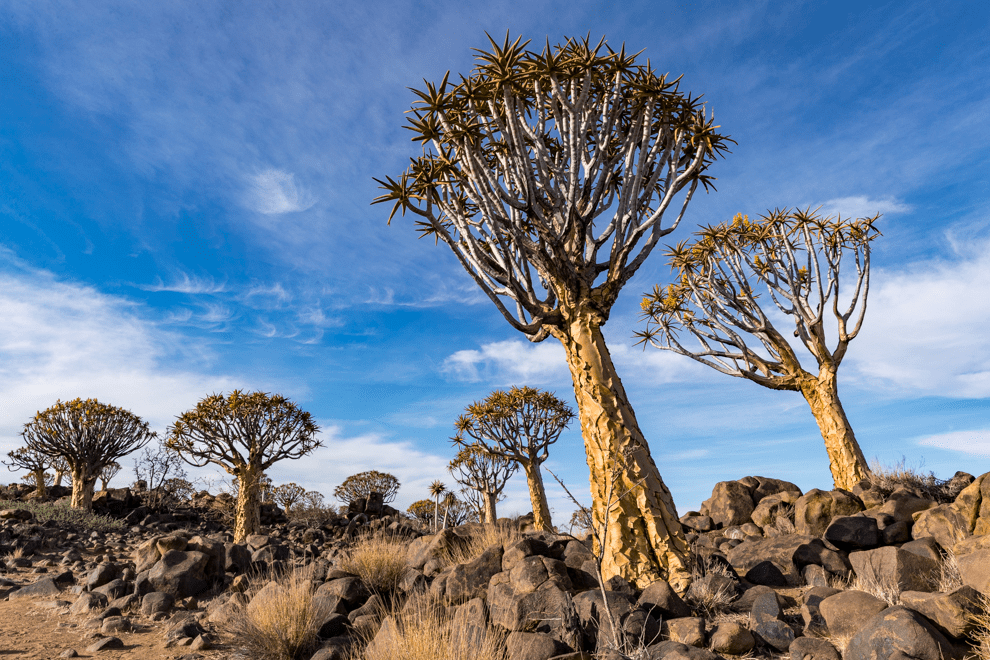
For the majority of the second trip around Namibia, we were treated with clear blue skies. However, on this first day, there was some broken cloud which gave a beautiful sunset. Exposing for the sky, the distinctive shape of quiver trees is thrown into silhouette.
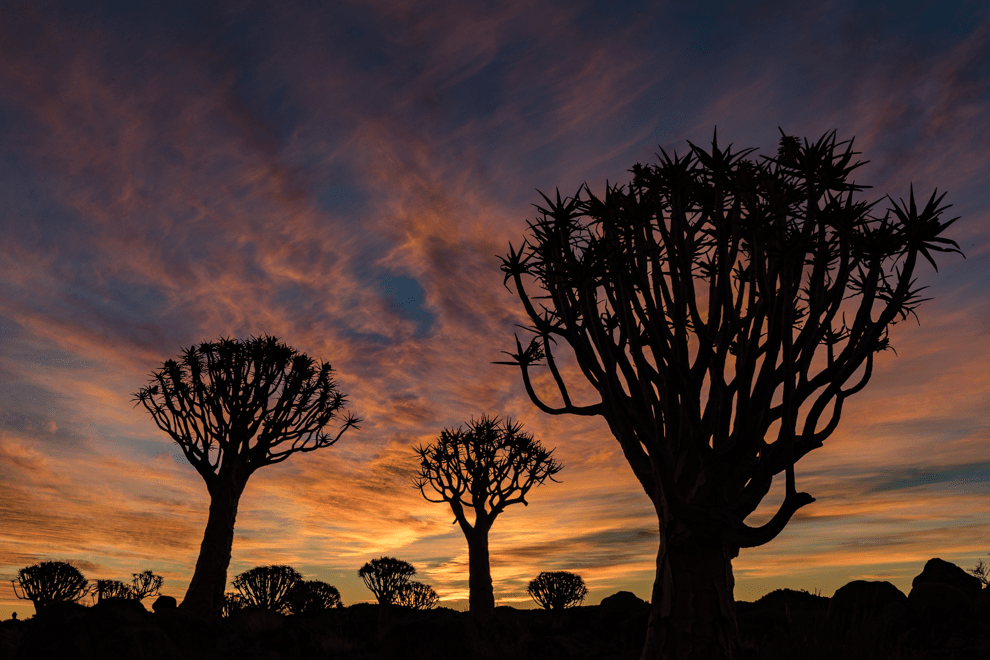
Luderitz
The second location of the tour takes us to the Atlantic coast. I visited the ghost town of Kolmanskop on the first trip. My visit coincided with 24 hours of rain, so the conditions weren’t ideal then. This visit was much better weather and so it was possible to capture shafts of light entering the derelict buildings. I like this room where someone had helpfully added a rock to the small sand dunes which are starting to take over the buildings.
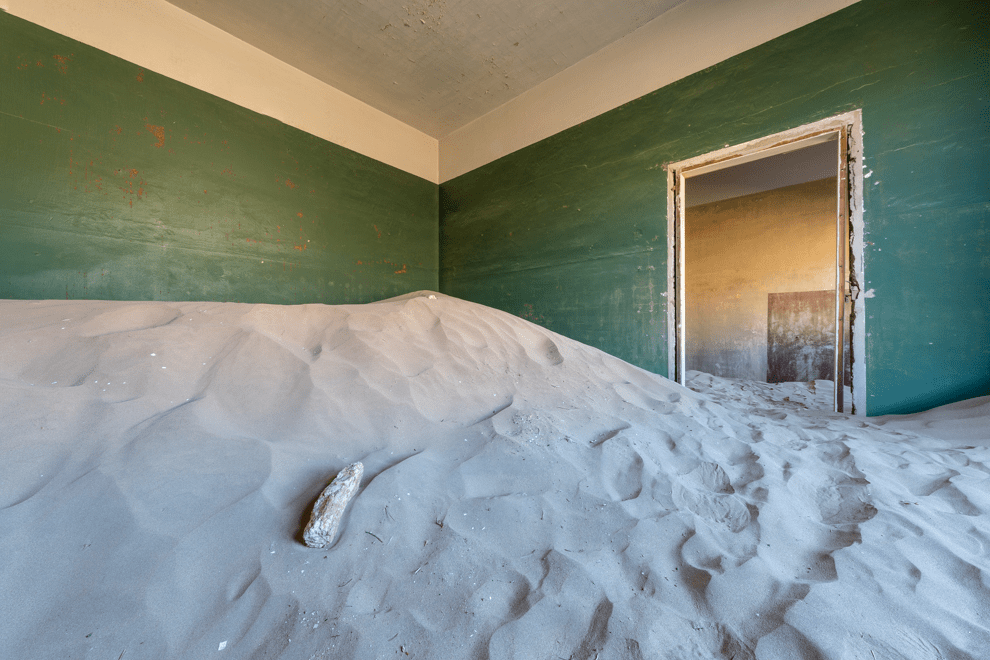
Diamonds are still being mined in the area around Luderitz. The tour had planned to get access to a working mine beyond Kolmanskop at Elizabeth Bay. After passing through security we could access another ghost-town. The condition of these buildings is much worse as they are battered by the Atlantic winds. The room in the next photograph has a bittersweet story attached to it. The miner who lived in this house wanted his wife to join him at Elizabeth Bay. To convince her to come, he painted an idyllic beach scene onto one of the walls and photographed it, telling her this was the view from his window. She didn’t join him, and the mining town closed a few months later, but the picture still remains.
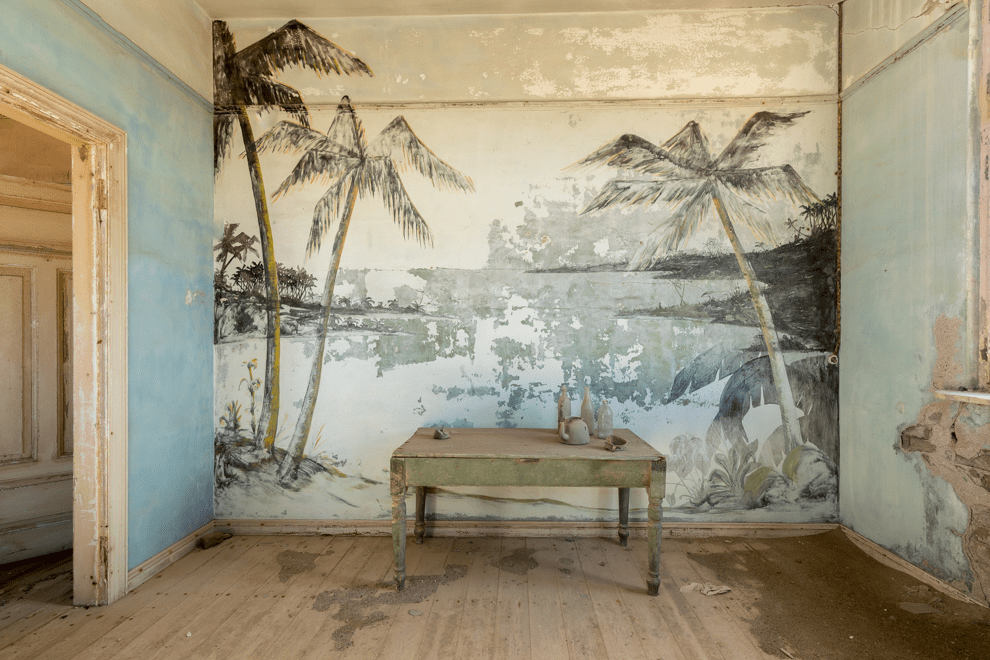
The final photograph of this section is taken around 100km from Luderitz. When the German occupiers left the area in the early 1900s, they left their horses behind. Remarkably, the horses adapted to the desert conditions and their descendants now roam the Namib desert near the town of Aus.
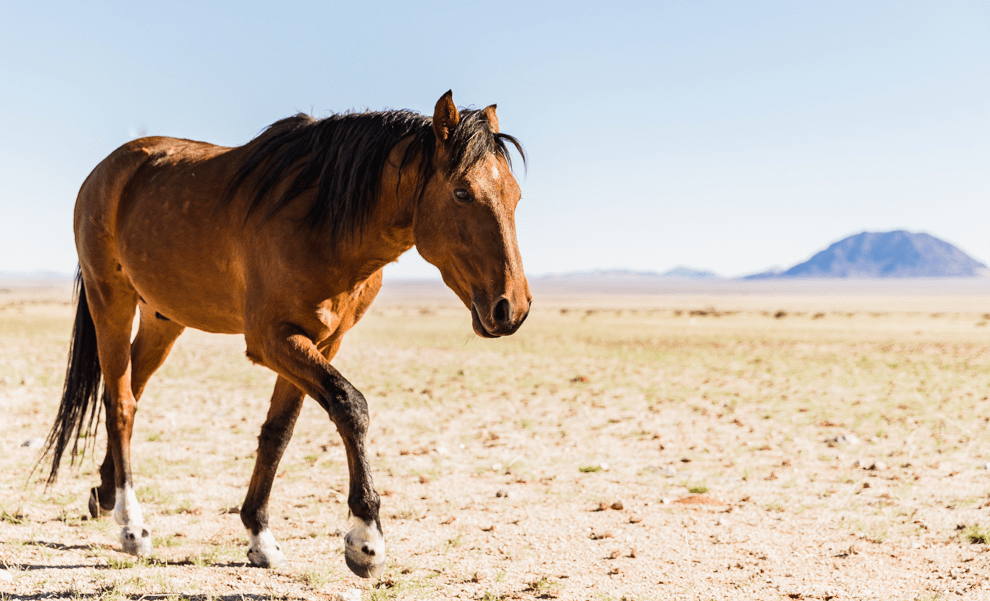
Sossusvlei
The petrified camel thorn trees of Deadvlei were the original draw for me to visit Namibia. On my first visit, I had stayed just outside the park which meant it wasn’t possible to enter the gates until dawn. On this trip, we stayed inside the park which gave us the opportunity to make the 60km drive to Deadvlei earlier. The benefit of this is that it is possible to capture the trees in silhouette and the dunes behind getting lit up by the sun rising over the top of the Big Daddy dune, which was behind us in the scene below.
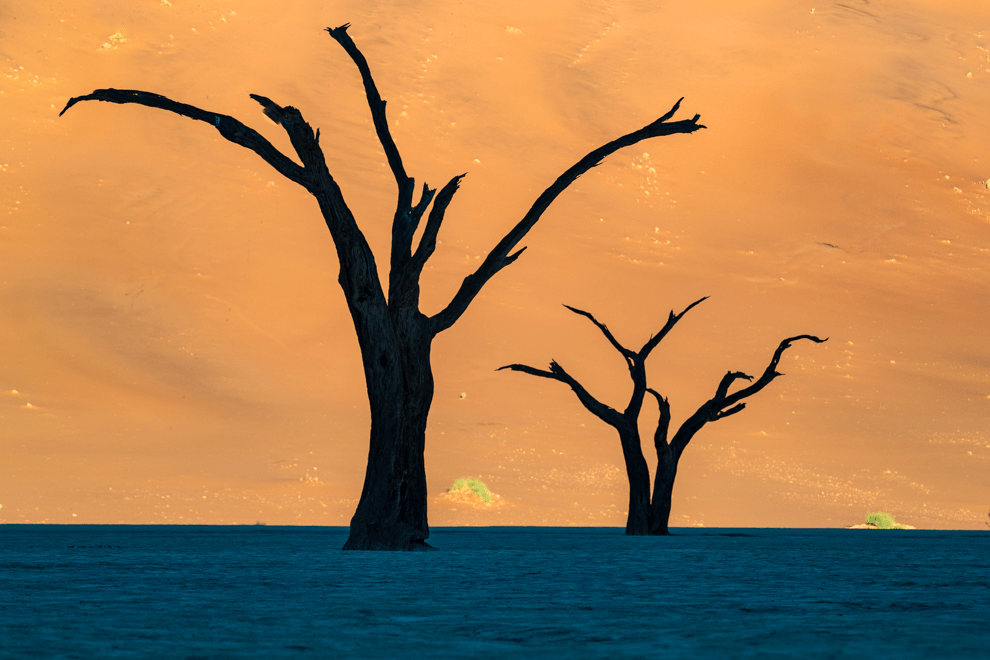
The road from the entry gate at Sesriem to the Deadvlei is just over 60km long. On either side of the road are dunes that are named depending on how many kilometres they are from the gate. On the previous trip I had visited this dune (number 38) in the morning so it was interesting to see it in the late afternoon light. The three acacia trees at the bottom of the dune give a pleasing foreground interest to the shot, although it is quite difficult to create separation between the trees and the shadows.
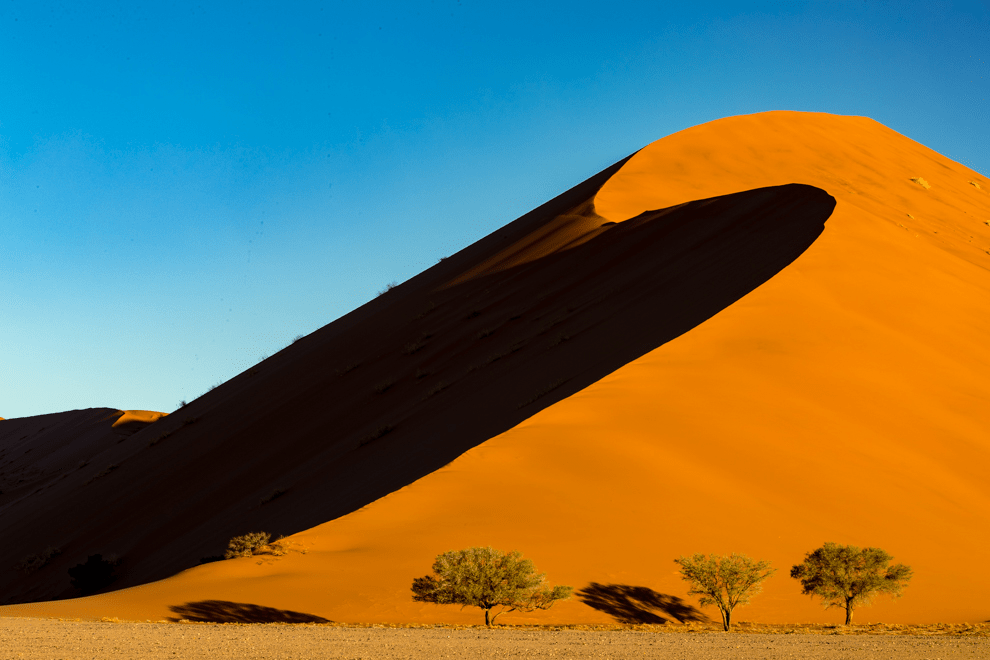
This final photograph of the Deadvlei is actually taken to the north-west of the famous vlei. The ground in this area is a lot rockier so you can’t get the nice neat lines as the sun rises. However, I really like the contrast of the blue sky and the various hues of the sand.

Walvis Bay
Heading north-wards our next location was the coastal town of Walvis Bay. The area is famous for its birdlife with an abundance of flamingo and pelican. We had arranged to take a drive out to Sandwich Harbour which is usually home to a large flamingo colony. The drive to the harbour was thrilling with our 4×4 drivers having to dodge waves coming in from the Atlantic. At one point there was a tiny gap between the crashing waves on the right and towering dunes on the left to squeeze the vehicle through without being taken out to sea.
Unfortunately, when we arrived at the harbour the flamingos weren’t there. The tour had been time-packed to this point so for some it was a welcome break to have a bit of free time. The journey back in the 4×4 vehicles took us over huge sand dunes. The shot below gives an indication of the vast terrain.
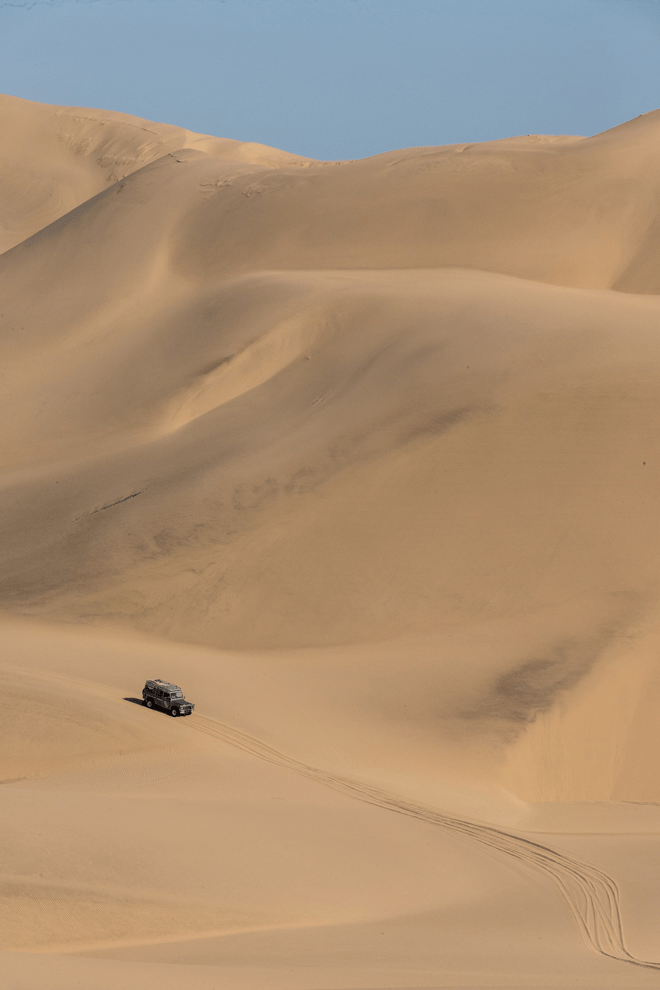
Upon returning to the hotel for the evening, a group of flamingos were in the water across the road. A short walk along the promenade allowed me to capture this lovely scene of a single bird in front of the setting sun. One of the difficulties of shooting large groups of birds is trying to isolate a subject. I think I was quite lucky to have the bird move into a bit of space of its own to create a simple but effective shot.
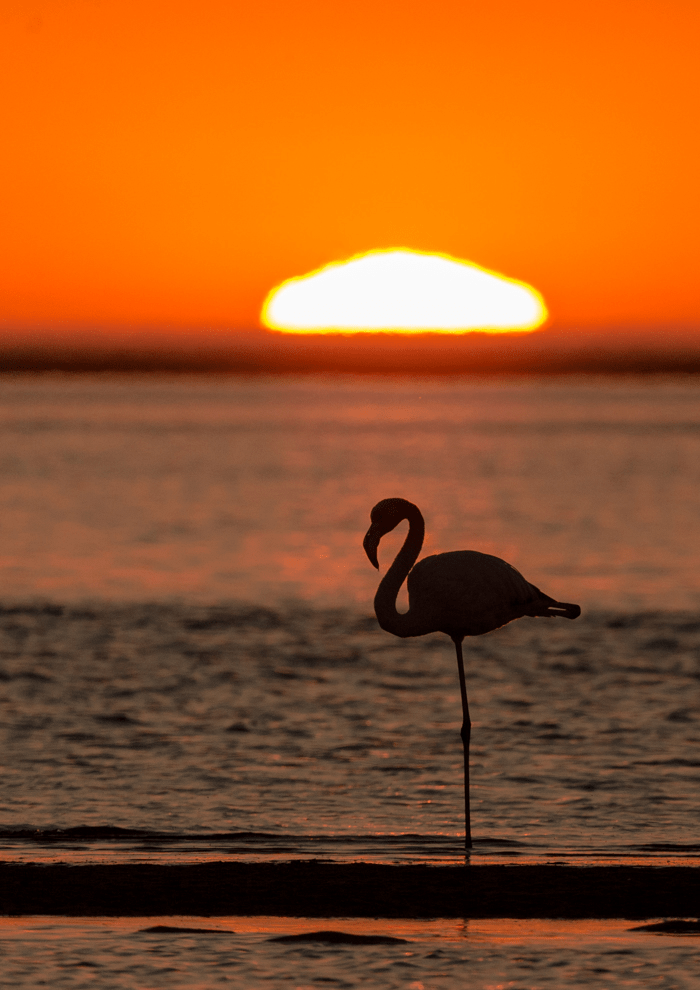
Skeleton Coast and Damaraland
The following day we headed further north with another long drive. The Skeleton Coast stretches from Walvis Bay toward Angola. The name was coined by John Henry Marsh as the title of a book he wrote about a shipwreck which was beached on the coastline. The book was published in 1944 and since then the name has been used to describe this barren area. The prevalence of mists and strong winds have led to many ships getting into trouble and beaching along the shore.
The boat in the next photograph was beached in 2008. It was being towed to Chine where it would be scrapped. During the journey, it broke free and then settled onto the beach at Henties Bay, close to where it still remains today. The coastal conditions here were particularly difficult to photograph in, with strong winds making long exposures almost impossible.
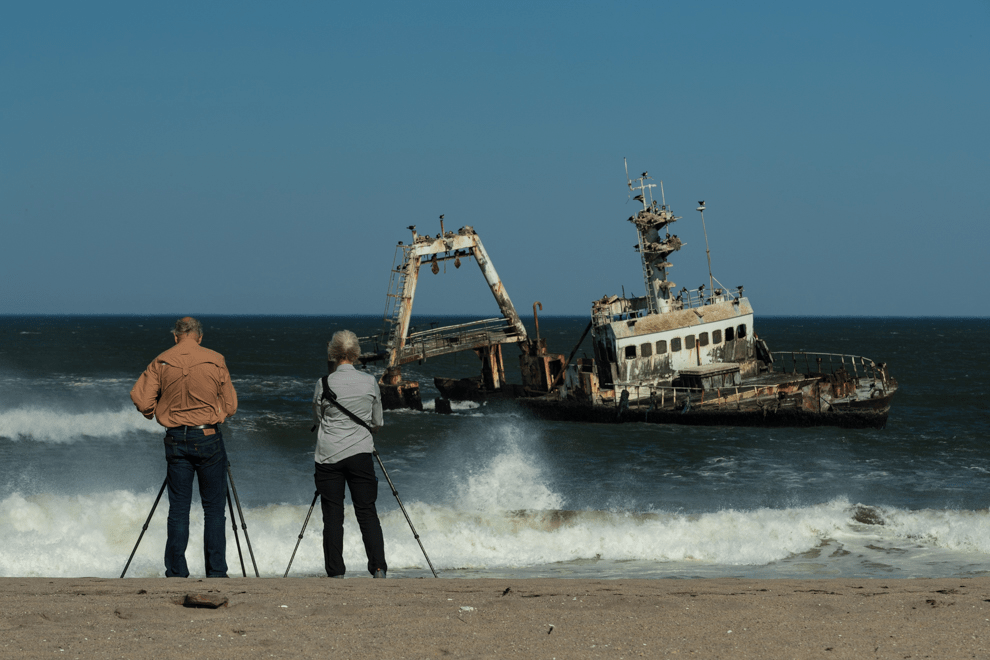
Our journey northwards gave us the opportunity to visit one of the Himba tribes that reside in the Kunene region of Namibia. The Himba tribe are indigenous to Namibia with around 50,000 living in the area, many retaining their traditional ways. The Himba are famous for covering themselves with otjize paste, a mixture of butter-fat and ochre. It is said to provide long-term cleansing as well as protecting the skin from the arid heat and mosquitos. It also gives the skin a red hue, which you can see with the photograph of this girl. The photograph was taken inside a Himba home, a small mud-hut. Home to a family of 6 people, it was just big enough inside to use a 24-70mm lens.

The Himba village we visited did seem quite used to visitors. Martin has visited this village previously and has photographed this girl on a number of occasions. Toward the end of the visit, the women of the village and a few of the men performed a series of songs and dances. You can get a feel for the energy from the shot below.

West Etosha
The penultimate stopping point of the trip was a private game reserve just outside the Etosha National Park. The private reserves are relatively small compared to the national parks, so their guides can be fairly certain of finding any of the big five they have on the reserve. The drive on the first evening came across a group of lionesses by a watering hole. Their interest was taken with two giraffes who were in need of a drink. The giraffe had spotted the pride, so they were wisely staying away from the watering hole where they would be vulnerable to attack. Over the course of almost an hour, we watched as the stand-off carried on. Eventually, a lion arrived on the scene. Lions are notoriously lazy and won’t expend effort unless the chances of a kill are high. He obviously thought the chase wasn’t worth it as he left the watering hole after a short drink, with the giraffe looking on in relief. Look closely at the lion though – he was obviously hungry enough to be licking his lips!
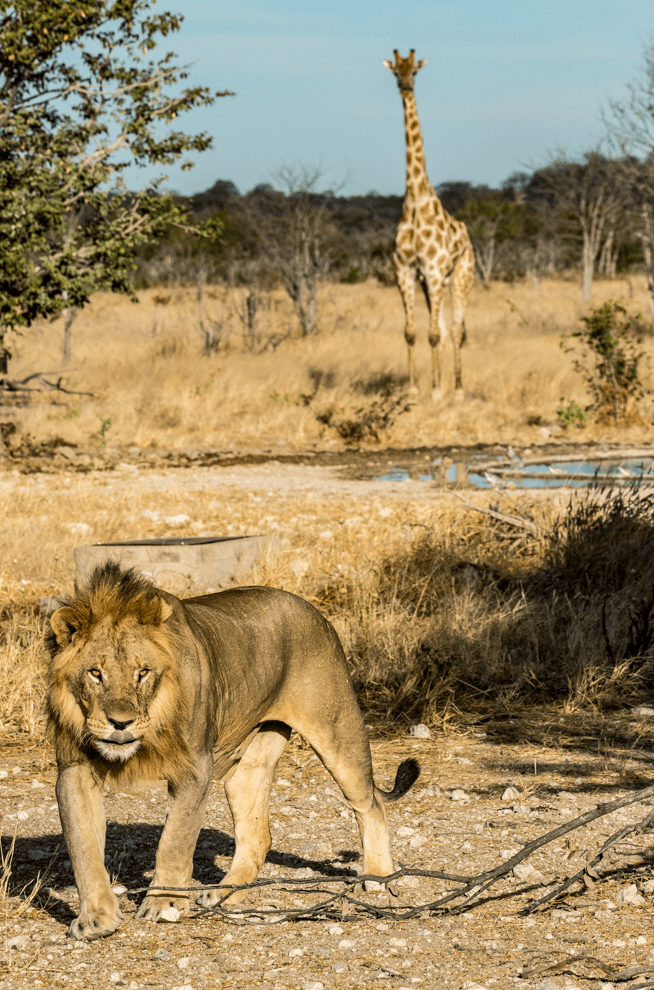
The following morning, we headed out into the National Park. Our guide spotted a large group of zebra and wildebeest moving towards a watering hole behind a small hill. He told me a lion must be nearby and sure enough, as we travelled over the hill, a large lion was sleeping in the grass. Even in this position the rest of the animals treated the ‘king of the jungle’ with respect. The photograph below looks like he is roaring but the reality is that it’s just a big yawn and the zebra looking back was just a lucky coincidence.
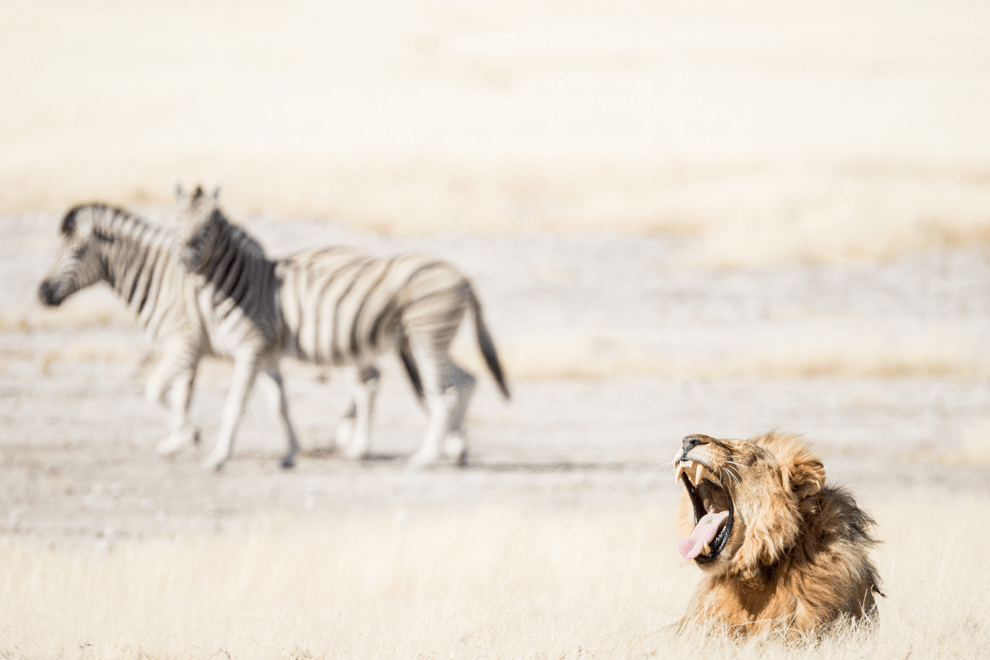
The next two photographs were taken within minutes of each other. At another watering hole we arrived to find a single elephant drinking. Within minutes what seemed like hundreds of zebra arrived and appeared to bully the lone elephant out of the water. He gave away to the dazzle of zebra (who knew that was the collective noun for zebra?) but not without making a loud trumpeting sound. As we watched the zebra having fun in the watering hole, in the distance a group of four elephants appeared on the horizon. The trumpeting was obviously a call for help. Within seconds of the elephants arriving at the hole, the zebra cleared out and two of the elephants appear to have a celebratory trunk-shake to celebrate regaining their territory.
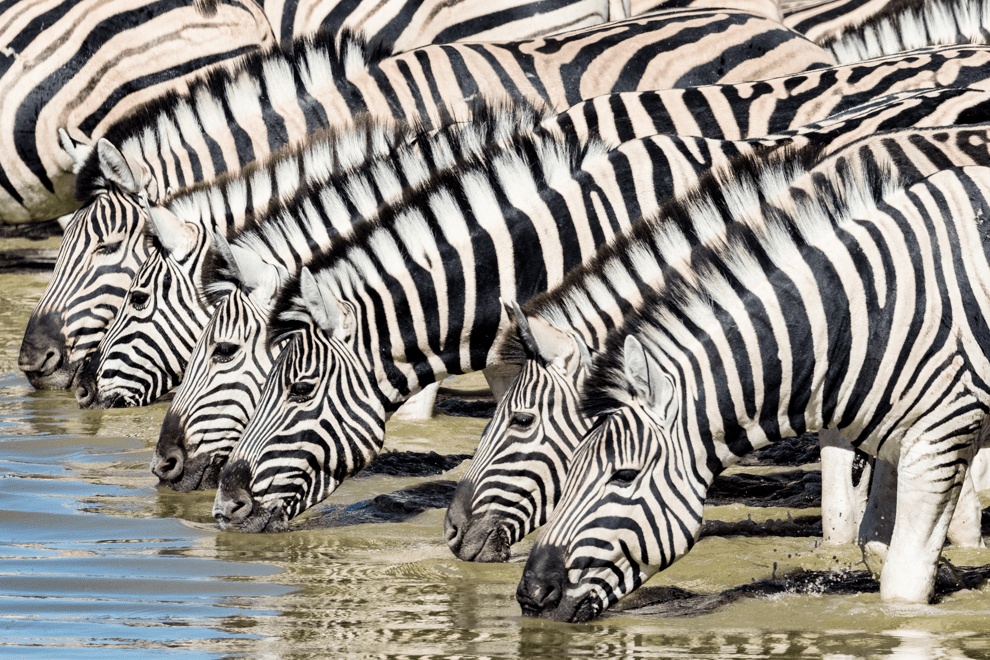
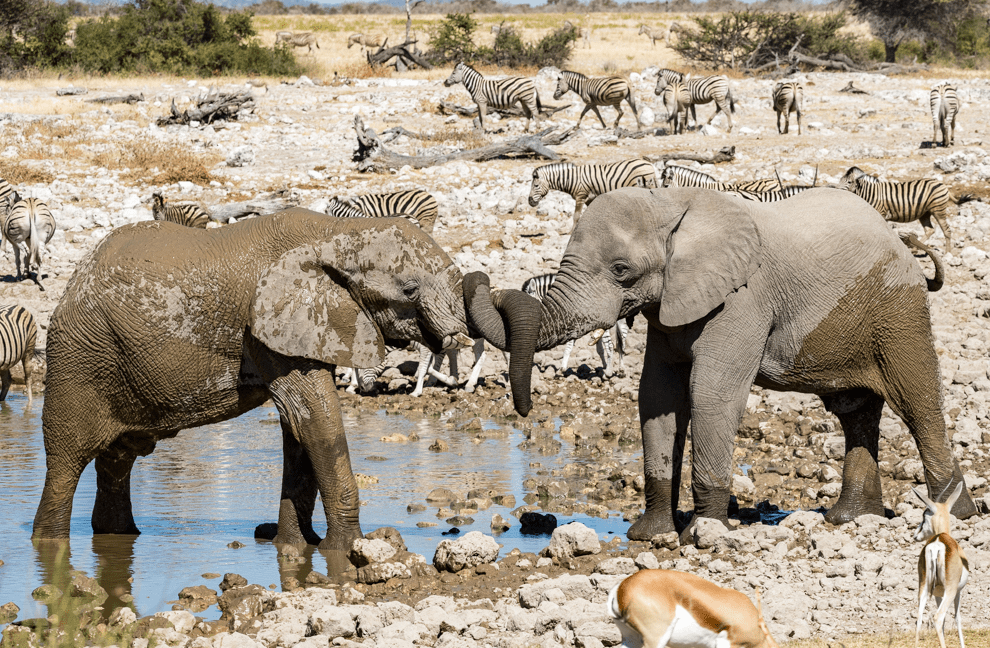
The final photograph of the section gives an indication of just how close we managed to get to some huge game. Rhino are notoriously dangerous and can easily charge if they feel slightly threatened. Driving through the game reserve we came across a group of rhino, very close to the track we were driving on. As we tried to get into position for photographs one of the beasts moved in front of the jeeps, giving us a real close-up view of this magnificent animal.
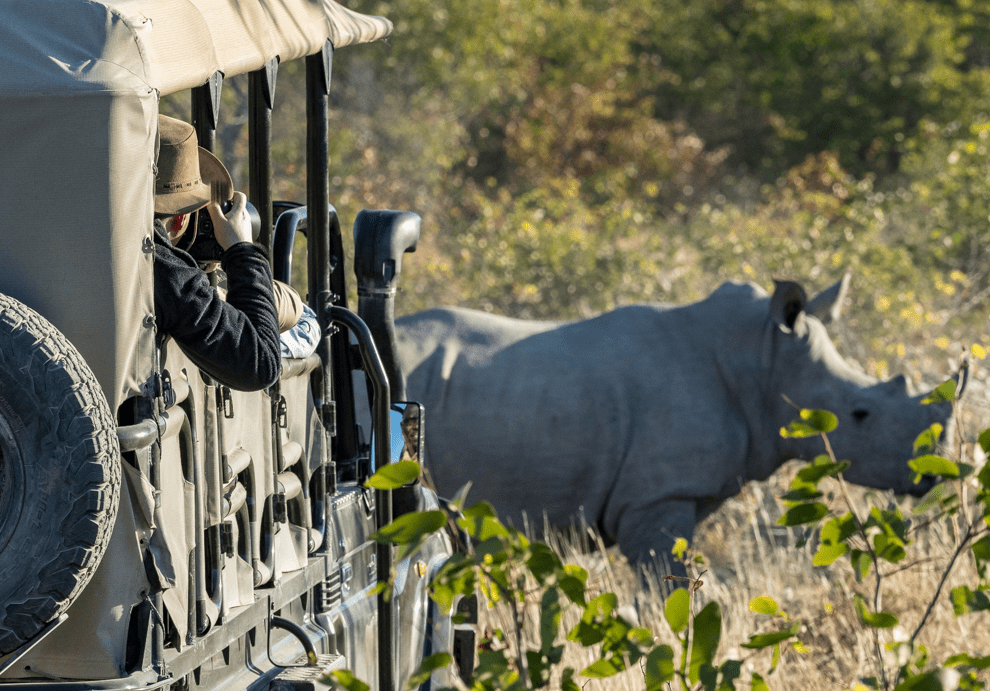
East Etosha
The final leg of the tour took us across the Etosha pan for another full-day of wildlife photography. As in my previous trip there appeared to be more animals on the east side including this long line of zebra snaking across the savannah. Being the tour leader for the vehicle I was travelling in, I wanted to ensure the guests got a great shot. The vehicles we were travelling in allowing those in the back to lift the roof and shoot from a higher viewpoint. I asked the guide to park the car so they had a nice S shape of the zebra walking toward us. Sitting in the front seats I couldn’t get the same shot but I am still happy with this line of animals making their way through the grass.
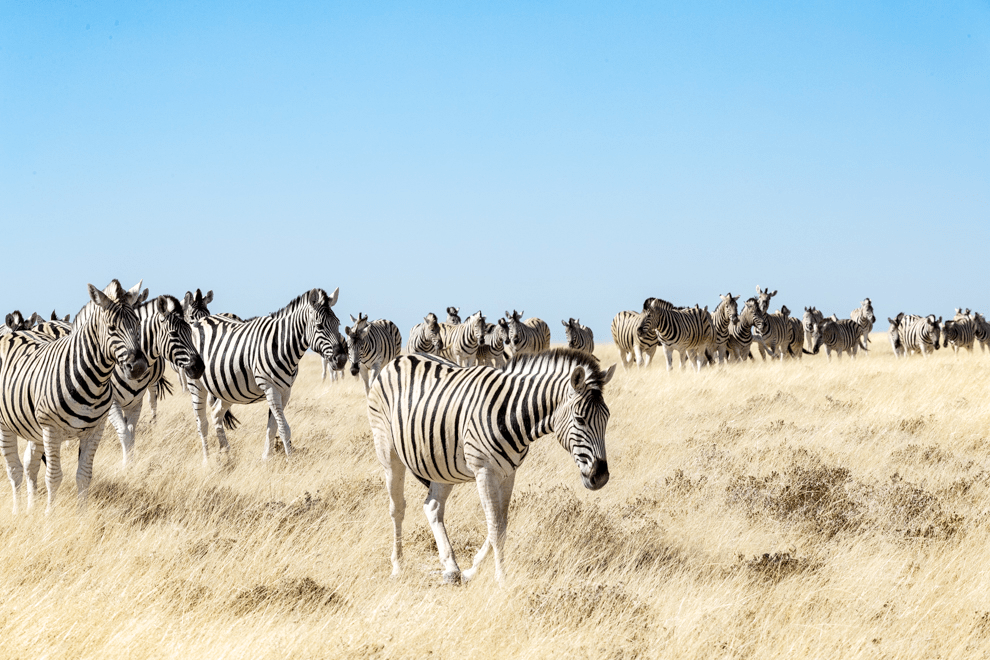
This next shot is one I wanted to add to give a sense of the joy you get from watching wild animals. A group of elephants were drinking and bathing in one of the watering-holes. The group included two very young calves. Just like any toddler they were running around their parents causing all the photographers in the car to chuckle at their antics whilst snapping away. This little one on the right reminds me of the film Dumbo, sitting on his bottom and pushing his trunk into the air.

I’ll finish with this last shot of the lodge where we stayed in East Etosha. The skies of Namibia are generally clear and there is little in the way of light pollution. As a result, the night skies are a blanket of stars and the wonder of the Milky Way is clearly visible most evenings during the viewing season. You can read how I shot and processed this image in last week’s blog.
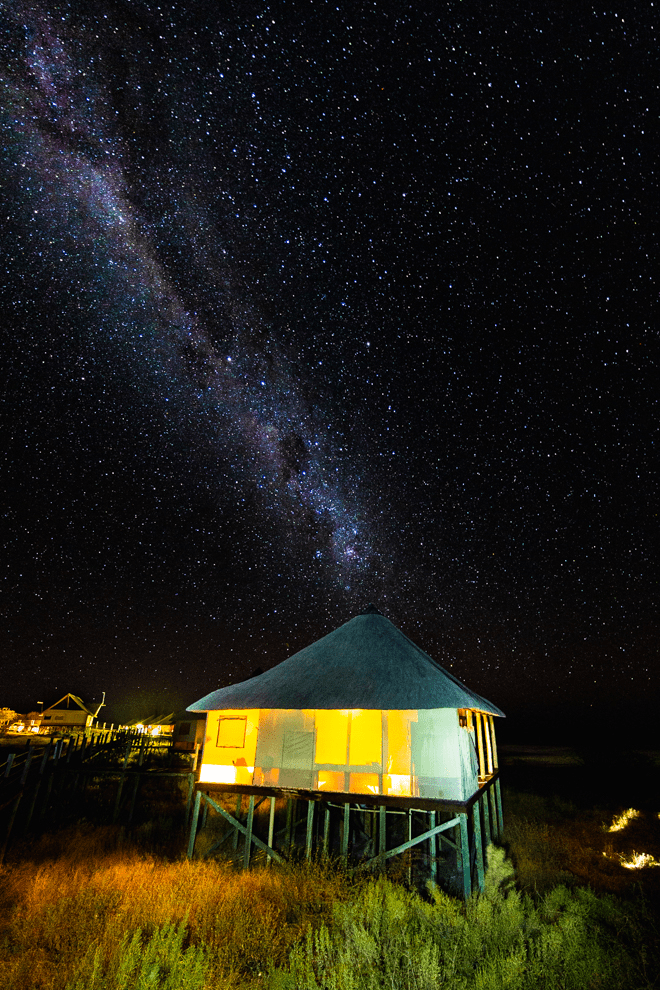
Is Namibia for you?
If you have enjoyed these two posts about Namibia, then you may want to visit the country too. I am going to be speaking at a number of camera clubs in the coming months comparing and contrasting travelling either on an organised tour or self-driving. If you would like me to visit your club or society then drop me a mail from the contact page. Martin Bailey is running another Complete Namibia tour in June 2019 – you can find more information on his website.